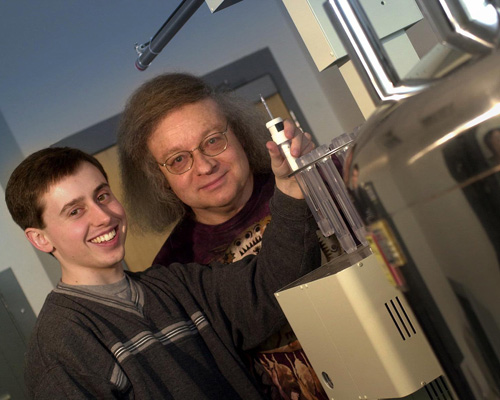Marquis Scholar Dan Swarr of Clifton Park, N.Y., is carrying out research that may yield a better understanding of certain proteins that are essential for functions that sustain life.
Swarr, a graduate of Shenendehowa High School, is participating in Lafayette’s EXCEL Scholars program, in which students collaborate closely with faculty on research projects while earning a stipend. He’s working with Bradley C. Antanaitis, associate professor of physics.
“Each of the proteins we’re examining contains a pair of iron atoms in its functional center — a spin-coupled binuclear metal center. The juxtaposed irons interact strongly, producing a variety of intriguing effects,” Antanaitis explains. “When you put this center in different protein environments, it behaves quite differently. Suppose I give you a red ball, and when you put it in one environment, it looks blue, in another, purple, and in a third, yellow. Here at the protein level we are seeing something equivalent to that. One of our main goals is to discover what allows this unit to be so versatile in different environments.”
Antanaitis and Swarr are hoping to work out a mathematical model that will yield a greater understanding of the functions and structural features of these spin-coupled binuclear metal centers.
“Sometimes nature produces mutated proteins that differ from the original and don’t work right. We are also trying to understand how this happens,” Antanaitis adds.
Swarr notes that while the current research does not have a medical focus, its conclusions could help other researchers studying proteins for a variety of reasons. For example, by building on this knowledge, others may gain a better understanding of conditions that lead to sickle cell anemia, a genetic disorder where mutated hemoglobin molecules produce misshapen red blood cells that do not circulate properly.
In this interdisciplinary research Swarr has assimilated an enormous amount of background material from several different fields.
“While that makes things harder, it’s good because it compels me to do a lot of studying to learn a great deal that will help me down the road,” says Swarr, who wants to carry out physics research and/or teach after graduating from Lafayette.
For now, he’s enjoying a valuable relationship with his EXCEL mentor.
“Professor Antanaitis has been a great person to work with,” Swarr explains. “He’s a fantastic teacher and a good person, too. He’s taught me a lot about physics and how to do research and he’s been a good friend.”
Another Side of Dan
In 2000-01 he will be a member of the McKelvy House Scholars program. In the McKelvy program, 19 students of high academic achievement and promise reside together in a historic home and participate in shared intellectual and social activities. After-dinner discussions and debates, held twice weekly, are a hallmark of the program. An active member of the Physics Club and Math Club, he is also a technician at WJRH, the campus radio station.

Goldwater Scholarship. Daniel Swarr ’03 received a Goldwater Scholarship, the premier national undergraduate award of its type in math, science, and engineering. One of his research mentors is Bradley Antanaitis, associate professor of physics.
